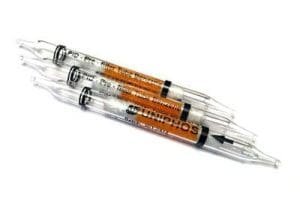 Our team of technical experts at Uniphos Envirotronic Inc. have been receiving increased inquiries on our PID Pre-filter tube for Benzene. We wanted to share some of the questions that have come up to assist our broader customer base in determining their gas detection needs related to benzene.
Our team of technical experts at Uniphos Envirotronic Inc. have been receiving increased inquiries on our PID Pre-filter tube for Benzene. We wanted to share some of the questions that have come up to assist our broader customer base in determining their gas detection needs related to benzene.
Benzene naturally occurs in crude oil and is used to make plastics, resins, synthetic fibers, dyes, detergents, additives and coatings, and pesticides. It is a widely used aromatic hydrocarbon which constitutes 1-2 percent of gasoline and other fuels. While benzene is a very useful hydrocarbon that offers diverse applications, it is also a known human carcinogen.
[/toggle] [toggle title=”What are some of the risks of benzene exposure?”]According to the American Cancer Society, benzene is known to cause cancer, with leukemia being one of the greatest risks, along with other cancers of blood cells. The International Agency for Research on Cancer states that benzene exposure has been linked with acute lymphocytic leukemia (ALL), chronic lymphocytic leukemia (CLL), multiple myeloma, and non-Hodgkin lymphoma.
[/toggle] [toggle title=”Which workplaces are at greatest risk for benzene exposure?”]Industries identified at greatest risk for benzene exposure include the rubber industry, refineries, petrochemical plants, shoe manufacturers and importers of leather goods. In addition, steel workers, printers, lab technicians, gas station employees and firefighters are also at risk.
[/toggle] [toggle title=”What are industry regulations to control benzene levels?”]Occupational Safety and Health Administration (OSHA) lists the PEL-TWA at 1 ppm, and the American Conference of Governmental Industrial Hygienists (ACGIH) have the TLV-TWA at 0.5 ppm. Industry requires a means to measure low concentrations of benzene (typically below 1 ppm) in the presence of various hydrocarbons, often 100 to 1000X the concentration of benzene.
[/toggle] [toggle title=”What are some of the best practices around using pre-filter benzene tubes?”]There are several ways to ensure the best outcome when using pre-filter benzene tubes. These include:
- Pre-filter tubes are designed for use with a particular instrument; you should always calibrate the instrument with a fresh pre-filter tube
- Use a new tube for each measurement – The discoloration occurs from the inside, and trace levels may not produce a visible color change
- Never use tubes beyond the manufacturer’s expiration data – Old tubes cannot be relied upon for accurate results; colorimetric reagents have a finite shelf life
- Keep tubes in the original package to protect the tubes from exposure to light – Chemical indicating systems are photosensitive, some more so than others
- Observe the manufacturer’s storage temperature printed on the package – Storage of tubes at high or low temperatures may adversely affect the color chemistry; follow the storage temperature specified on the package
Contact our team today at 1-844-247-0450 to find out more! Other questions? Add a comment/question below and we’ll get back to you!






